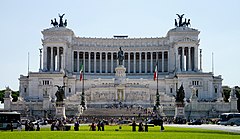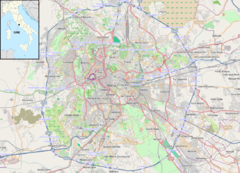Altare della Patria
From Wikipedia, the free encyclopedia
This article is about the monument in Rome. For the mausoleum in Santo Domigo, see Altar de la Patria.
| Altare della Patria | |
|---|---|

The Altare della Patria.
| |
|
Location within Rome
| |
| Alternative names | "Monumento Nazionale a Vittorio Emanuele II" "Il Vittoriano" |
| General information | |
| Type | Monument |
| Location | Rome, Italy |
| Coordinates | 41.894599°N 12.483092°ECoordinates: 41.894599°N 12.483092°E |
| Construction started | 1885 |
| Completed | 1925 |
| Inaugurated | 1911 |
| Height | 70 m (230 ft) |
| Design and construction | |
| Architect | Giuseppe Sacconi |
The Altare della Patria ([alˈtaːre della ˈpaːtrja]; English: "Altar of the Fatherland"), also known as the Monumento Nazionale a Vittorio Emanuele II ("National Monument to Victor Emmanuel II") or Il Vittoriano, is a monument built in honor of Victor Emmanuel, the first king of a unified Italy, located in Rome, Italy. It occupies a site between the Piazza Venezia and the Capitoline Hill.
The eclectic structure was designed by Giuseppe Sacconi in 1885; sculpture for it was parceled out to established sculptors all over Italy, such as Leonardo Bistolfi and Angelo Zanelli.[1] It was inaugurated in 1911 and completed in 1925.[2]
The Vittoriano features stairways, Corinthian columns, fountains, an equestrian sculpture of Victor Emmanuel and two statues of the goddess Victoria riding on quadrigas. The structure is 135 m (443 ft) wide and 70 m (230 ft) high. If the quadrigae and winged victories are included, the height reaches 81 m (266 ft).[2] It has a total area of 17,000 square metres.
The base of the structure houses the museum of Italian Unification.[2][3] In 2007, a panoramic lift was added to the structure, allowing visitors to ride up to the roof for 360-degree views of Rome.[4]
Unknown soldier[edit]
The monument holds the Tomb of the Unknown Soldier with an eternal flame, built under the statue of goddess Roma after World War I following an idea of General Giulio Douhet. The body of the unknown soldier was chosen on 26 October 1921 from among 11 unknown remains by Maria Bergamas, a woman from Gradisca d'Isonzo whose only child was killed during World War I. Her son's body was never recovered. The selected unknown was transferred from Aquileia, where the ceremony with Bergamas had taken place, to Rome and buried in a state funeral on 4 November 1921.
Military colours[edit]
The flags of disbanded units of the Italian Armed Forces, as well as the flags of ships stricken from the naval register of the Italian Navy are stored at the Vittoriano in the so-called Shrine of the Flags (Sacrario delle Bandiere). The oldest flag on display is the flag of the 19th-century frigate Giuseppe Garibaldi.
Controversy[edit]
The monument, the largest in Rome, was controversial since its construction destroyed a large area of the Capitoline Hill with a Medievalneighbourhood for its sake.[5] The monument itself is often regarded as conspicuous,[5] pompous and too large.[3][6][7]
It has been described as being "chopped with terrible brutality into the immensely complicated fabric of the hill".[8]
It is clearly visible to most of the city of Rome despite being boxy in general shape and lacking a dome or a tower.[2] The monument is also glaringly white, built from "corpse-white marble" imported from Botticino in Brescia, making it highly conspicuous amidst the generally brownish buildings surrounding it. For its shape and conspicuous nature, Romans have given it a number of humorous and somewhat uncomplimentary nicknames, including la torta nuziale ("the wedding cake") and la zuppa inglese ("English soup" dessert).[9]






















No comments:
Post a Comment